Management Accounting Report - BTEC Level 4 Business, Semester 1
VerifiedAdded on 2023/01/12
|11
|3424
|44
Report
AI Summary
This management accounting report analyzes various techniques and tools used by organizations, focusing on a case study of Prime Furniture in London. The report covers microeconomic techniques such as cost analysis, cost-volume-profit, and flexible budgeting, along with absorption and marginal costing methods, supported by calculations and income statements. It delves into product costing, differentiating between fixed, variable, and overhead costs, and explores cost allocation and costing systems like normal, standard, and activity-based costing. The report further examines inventory costing, valuation methods, and budgeting for planning and control, including capital and operating budgets, and explores different pricing strategies. It also assesses strategic planning using PEST and SWOT analyses, Porter's five forces, and discusses methods for identifying financial problems, such as benchmarking and KPIs. The report provides a comprehensive overview of management accounting principles and their practical applications within a business context.
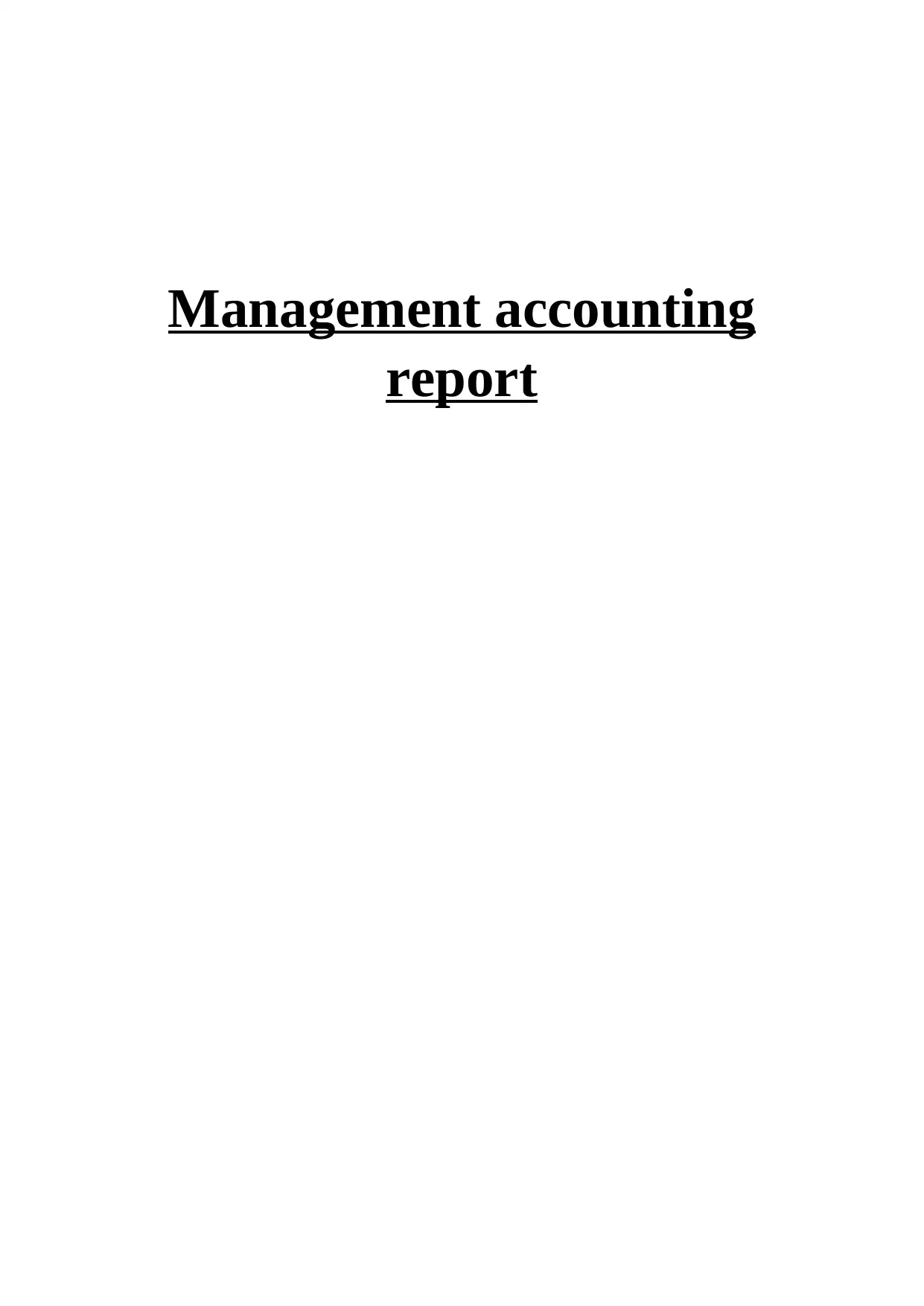
Management accounting
report
report
Paraphrase This Document
Need a fresh take? Get an instant paraphrase of this document with our AI Paraphraser
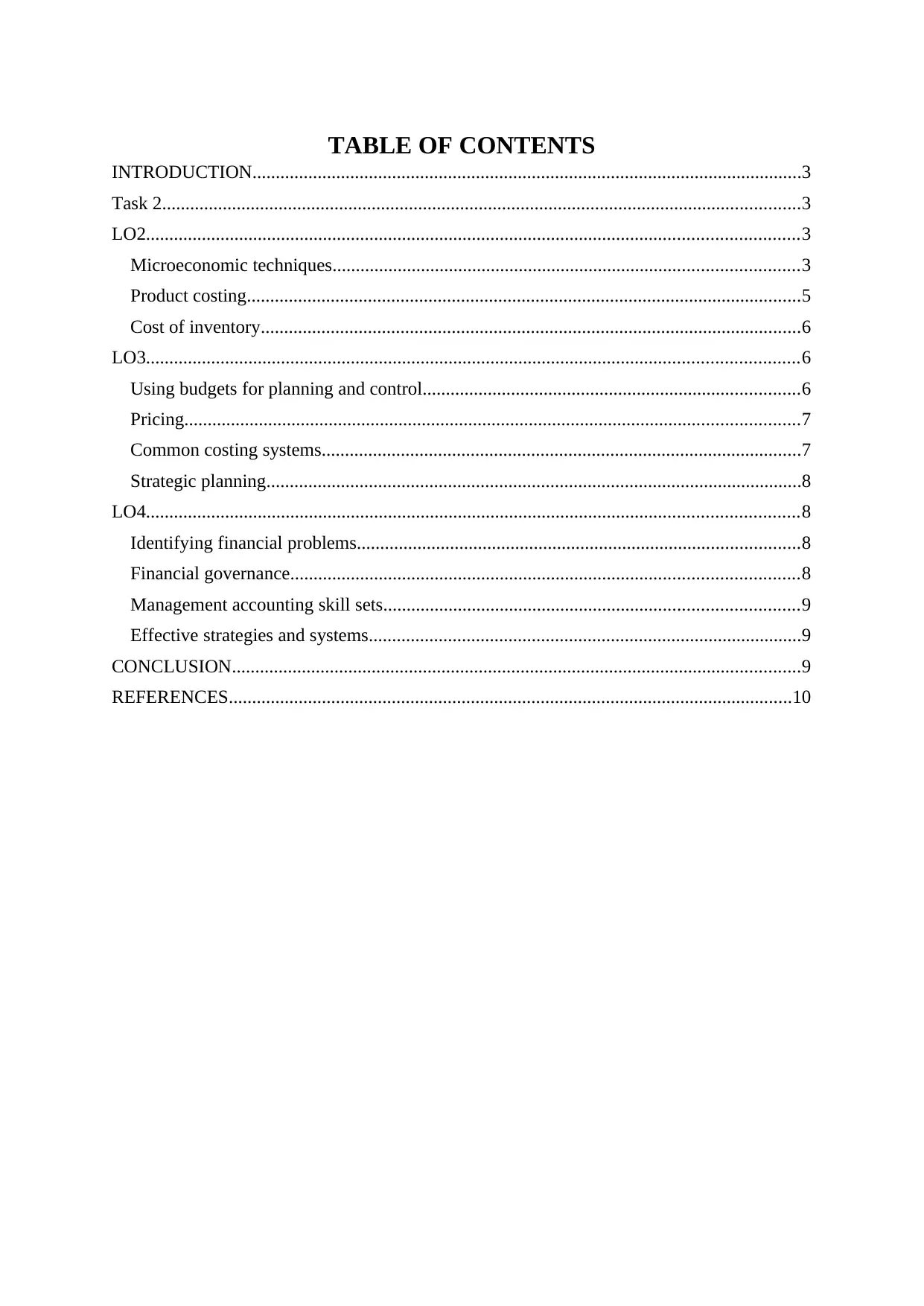
TABLE OF CONTENTS
INTRODUCTION......................................................................................................................3
Task 2.........................................................................................................................................3
LO2............................................................................................................................................3
Microeconomic techniques....................................................................................................3
Product costing.......................................................................................................................5
Cost of inventory....................................................................................................................6
LO3............................................................................................................................................6
Using budgets for planning and control.................................................................................6
Pricing....................................................................................................................................7
Common costing systems.......................................................................................................7
Strategic planning...................................................................................................................8
LO4............................................................................................................................................8
Identifying financial problems...............................................................................................8
Financial governance.............................................................................................................8
Management accounting skill sets.........................................................................................9
Effective strategies and systems.............................................................................................9
CONCLUSION..........................................................................................................................9
REFERENCES.........................................................................................................................10
INTRODUCTION......................................................................................................................3
Task 2.........................................................................................................................................3
LO2............................................................................................................................................3
Microeconomic techniques....................................................................................................3
Product costing.......................................................................................................................5
Cost of inventory....................................................................................................................6
LO3............................................................................................................................................6
Using budgets for planning and control.................................................................................6
Pricing....................................................................................................................................7
Common costing systems.......................................................................................................7
Strategic planning...................................................................................................................8
LO4............................................................................................................................................8
Identifying financial problems...............................................................................................8
Financial governance.............................................................................................................8
Management accounting skill sets.........................................................................................9
Effective strategies and systems.............................................................................................9
CONCLUSION..........................................................................................................................9
REFERENCES.........................................................................................................................10
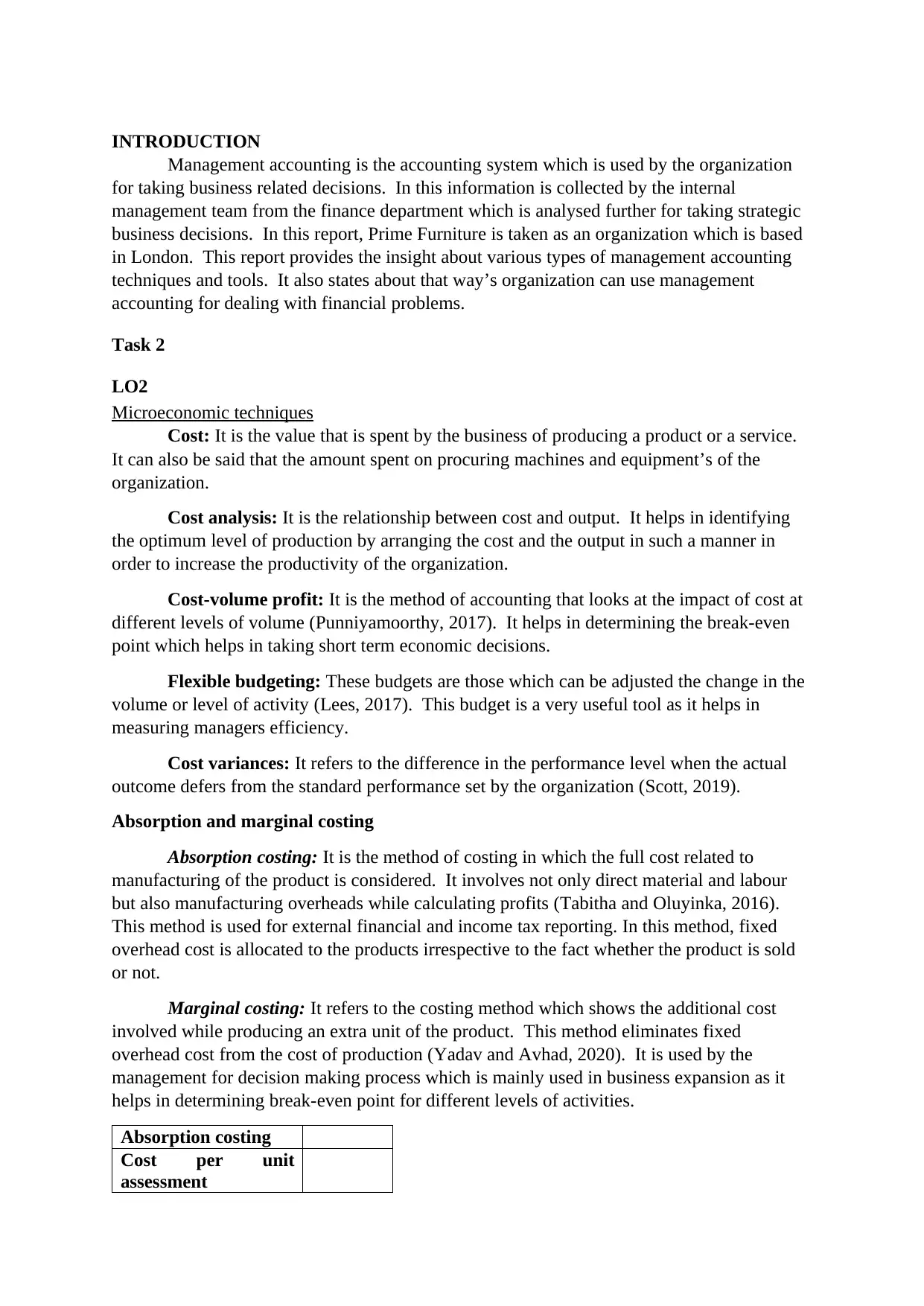
INTRODUCTION
Management accounting is the accounting system which is used by the organization
for taking business related decisions. In this information is collected by the internal
management team from the finance department which is analysed further for taking strategic
business decisions. In this report, Prime Furniture is taken as an organization which is based
in London. This report provides the insight about various types of management accounting
techniques and tools. It also states about that way’s organization can use management
accounting for dealing with financial problems.
Task 2
LO2
Microeconomic techniques
Cost: It is the value that is spent by the business of producing a product or a service.
It can also be said that the amount spent on procuring machines and equipment’s of the
organization.
Cost analysis: It is the relationship between cost and output. It helps in identifying
the optimum level of production by arranging the cost and the output in such a manner in
order to increase the productivity of the organization.
Cost-volume profit: It is the method of accounting that looks at the impact of cost at
different levels of volume (Punniyamoorthy, 2017). It helps in determining the break-even
point which helps in taking short term economic decisions.
Flexible budgeting: These budgets are those which can be adjusted the change in the
volume or level of activity (Lees, 2017). This budget is a very useful tool as it helps in
measuring managers efficiency.
Cost variances: It refers to the difference in the performance level when the actual
outcome defers from the standard performance set by the organization (Scott, 2019).
Absorption and marginal costing
Absorption costing: It is the method of costing in which the full cost related to
manufacturing of the product is considered. It involves not only direct material and labour
but also manufacturing overheads while calculating profits (Tabitha and Oluyinka, 2016).
This method is used for external financial and income tax reporting. In this method, fixed
overhead cost is allocated to the products irrespective to the fact whether the product is sold
or not.
Marginal costing: It refers to the costing method which shows the additional cost
involved while producing an extra unit of the product. This method eliminates fixed
overhead cost from the cost of production (Yadav and Avhad, 2020). It is used by the
management for decision making process which is mainly used in business expansion as it
helps in determining break-even point for different levels of activities.
Absorption costing
Cost per unit
assessment
Management accounting is the accounting system which is used by the organization
for taking business related decisions. In this information is collected by the internal
management team from the finance department which is analysed further for taking strategic
business decisions. In this report, Prime Furniture is taken as an organization which is based
in London. This report provides the insight about various types of management accounting
techniques and tools. It also states about that way’s organization can use management
accounting for dealing with financial problems.
Task 2
LO2
Microeconomic techniques
Cost: It is the value that is spent by the business of producing a product or a service.
It can also be said that the amount spent on procuring machines and equipment’s of the
organization.
Cost analysis: It is the relationship between cost and output. It helps in identifying
the optimum level of production by arranging the cost and the output in such a manner in
order to increase the productivity of the organization.
Cost-volume profit: It is the method of accounting that looks at the impact of cost at
different levels of volume (Punniyamoorthy, 2017). It helps in determining the break-even
point which helps in taking short term economic decisions.
Flexible budgeting: These budgets are those which can be adjusted the change in the
volume or level of activity (Lees, 2017). This budget is a very useful tool as it helps in
measuring managers efficiency.
Cost variances: It refers to the difference in the performance level when the actual
outcome defers from the standard performance set by the organization (Scott, 2019).
Absorption and marginal costing
Absorption costing: It is the method of costing in which the full cost related to
manufacturing of the product is considered. It involves not only direct material and labour
but also manufacturing overheads while calculating profits (Tabitha and Oluyinka, 2016).
This method is used for external financial and income tax reporting. In this method, fixed
overhead cost is allocated to the products irrespective to the fact whether the product is sold
or not.
Marginal costing: It refers to the costing method which shows the additional cost
involved while producing an extra unit of the product. This method eliminates fixed
overhead cost from the cost of production (Yadav and Avhad, 2020). It is used by the
management for decision making process which is mainly used in business expansion as it
helps in determining break-even point for different levels of activities.
Absorption costing
Cost per unit
assessment
⊘ This is a preview!⊘
Do you want full access?
Subscribe today to unlock all pages.

Trusted by 1+ million students worldwide

Particulars Figures
in £
Variable cost of
production
0.65
Fixed cost of
production
0.2
Total cost per unit 0.85
Calculating
COGS
Quarter
1
Quarter
2
Particulars Figures
in £
Figures
in £
Opening stock 0 (12000*0.85) 10200
Add:
purchases
(78000*0.85) 66300 (66000*0.85) 56100
Less: Closing
stock
(12000*0.85) 10200 (4000*0.85) 3400
COGS 56100 62900
Income statement
Quarter 1 Quarter 2
Particulars Figures in
£
Figures in
£
Sales 66000 74000
Less: COGS 56100 62900
Gross profit 9900 11100
Less: Selling and
administrative
expenses
5200 5200
Net profit 4700 5900
Marginal costing
Calculating
COGS
Quarter
1
Quarter
2
Particulars Figures
in £
Figures
in £
Opening stock 0 (12000*0.65) 7800
Add: purchases (78000*0.65) 50700 (66000*0.65) 42900
Less: Closing
stock
(12000*0.65) 7800 (4000*0.65) 2600
COGS 42900 48100
in £
Variable cost of
production
0.65
Fixed cost of
production
0.2
Total cost per unit 0.85
Calculating
COGS
Quarter
1
Quarter
2
Particulars Figures
in £
Figures
in £
Opening stock 0 (12000*0.85) 10200
Add:
purchases
(78000*0.85) 66300 (66000*0.85) 56100
Less: Closing
stock
(12000*0.85) 10200 (4000*0.85) 3400
COGS 56100 62900
Income statement
Quarter 1 Quarter 2
Particulars Figures in
£
Figures in
£
Sales 66000 74000
Less: COGS 56100 62900
Gross profit 9900 11100
Less: Selling and
administrative
expenses
5200 5200
Net profit 4700 5900
Marginal costing
Calculating
COGS
Quarter
1
Quarter
2
Particulars Figures
in £
Figures
in £
Opening stock 0 (12000*0.65) 7800
Add: purchases (78000*0.65) 50700 (66000*0.65) 42900
Less: Closing
stock
(12000*0.65) 7800 (4000*0.65) 2600
COGS 42900 48100
Paraphrase This Document
Need a fresh take? Get an instant paraphrase of this document with our AI Paraphraser
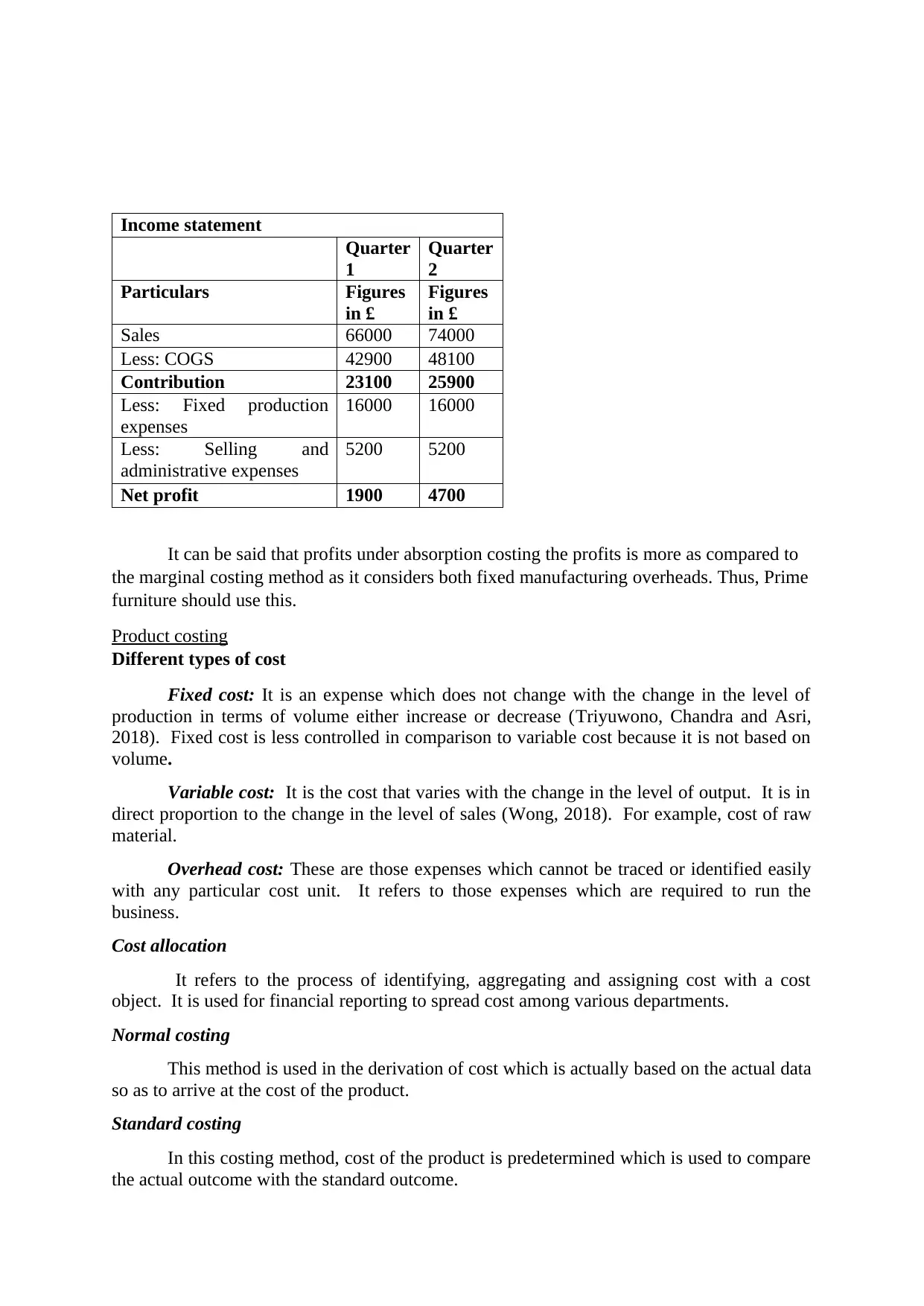
Income statement
Quarter
1
Quarter
2
Particulars Figures
in £
Figures
in £
Sales 66000 74000
Less: COGS 42900 48100
Contribution 23100 25900
Less: Fixed production
expenses
16000 16000
Less: Selling and
administrative expenses
5200 5200
Net profit 1900 4700
It can be said that profits under absorption costing the profits is more as compared to
the marginal costing method as it considers both fixed manufacturing overheads. Thus, Prime
furniture should use this.
Product costing
Different types of cost
Fixed cost: It is an expense which does not change with the change in the level of
production in terms of volume either increase or decrease (Triyuwono, Chandra and Asri,
2018). Fixed cost is less controlled in comparison to variable cost because it is not based on
volume.
Variable cost: It is the cost that varies with the change in the level of output. It is in
direct proportion to the change in the level of sales (Wong, 2018). For example, cost of raw
material.
Overhead cost: These are those expenses which cannot be traced or identified easily
with any particular cost unit. It refers to those expenses which are required to run the
business.
Cost allocation
It refers to the process of identifying, aggregating and assigning cost with a cost
object. It is used for financial reporting to spread cost among various departments.
Normal costing
This method is used in the derivation of cost which is actually based on the actual data
so as to arrive at the cost of the product.
Standard costing
In this costing method, cost of the product is predetermined which is used to compare
the actual outcome with the standard outcome.
Quarter
1
Quarter
2
Particulars Figures
in £
Figures
in £
Sales 66000 74000
Less: COGS 42900 48100
Contribution 23100 25900
Less: Fixed production
expenses
16000 16000
Less: Selling and
administrative expenses
5200 5200
Net profit 1900 4700
It can be said that profits under absorption costing the profits is more as compared to
the marginal costing method as it considers both fixed manufacturing overheads. Thus, Prime
furniture should use this.
Product costing
Different types of cost
Fixed cost: It is an expense which does not change with the change in the level of
production in terms of volume either increase or decrease (Triyuwono, Chandra and Asri,
2018). Fixed cost is less controlled in comparison to variable cost because it is not based on
volume.
Variable cost: It is the cost that varies with the change in the level of output. It is in
direct proportion to the change in the level of sales (Wong, 2018). For example, cost of raw
material.
Overhead cost: These are those expenses which cannot be traced or identified easily
with any particular cost unit. It refers to those expenses which are required to run the
business.
Cost allocation
It refers to the process of identifying, aggregating and assigning cost with a cost
object. It is used for financial reporting to spread cost among various departments.
Normal costing
This method is used in the derivation of cost which is actually based on the actual data
so as to arrive at the cost of the product.
Standard costing
In this costing method, cost of the product is predetermined which is used to compare
the actual outcome with the standard outcome.

Activity based costing
This method of costing identifies the different activities in the organization and then
assigns the cost incurred in activity to the particular product or services (Lueg and Storgaard,
2017).
Costing plays an important role in setting the price of the product as the
businesses adds the profit margin to the actual cost incurred on the product and then offers
the products and services in the market at the rate determined.
Cost of inventory
Inventory cost: It is the cost incurred with the purpose to procure, store and
management of inventory (Galdi and et.al, 2019). There are 2 types of inventory cost.
Ordering cost: it is the cost that is incurred for processing an order to a supplier. It is
included in the determining economic order quantity.
Carrying cost: it is the cost related to storing all the unsold goods. It includes all the
cost in respect to warehousing, transportation, handling, tax and insurance of the goods as
well as shrinkage and opportunity cost.
Reducing the inventory cost will result in increasing profit margins of the product and
also helps in increasing the profitability and efficiency of the business. Thus, it is very
beneficial.
Inventory valuation methods
First-in, first-out: This method is an assumption in which the goods which are
purchased first are supposed to be sold first. This method is considered the most suitable
method for valuing inventory.
Last-in, first-out: It is also based on assumption that the last item placed in the
inventory is to be sold out first by the end of the specific period.
Weighted average: Under this, cost of goods available is divided by the number of
units available which derives the weighted average cost per unit.
LO3
Using budgets for planning and control
Budget is a financial plan mostly prepared for a year. It includes estimated revenue
and expenses and cash flows of Prime Furnitures for a specific period. The two types of
budgets are stated below.
Capital budget: This budget is prepared in respect to investment. It helps in analysing
the future investment and expenditure (Soares and et.al, 2020). For instance, whether to
purchase new machinery or replace the existing one or whether to invest in the research and
development or not.
Operating budget: It is the forecast of the expected revenue and expenditure for the
future period which is expected by the business to achieve.
Alternative methods of budgeting
Incremental budgeting: It is the budget which is prepared either using previous year
budget or actual performance in which the additional amount is added or subtracted while
This method of costing identifies the different activities in the organization and then
assigns the cost incurred in activity to the particular product or services (Lueg and Storgaard,
2017).
Costing plays an important role in setting the price of the product as the
businesses adds the profit margin to the actual cost incurred on the product and then offers
the products and services in the market at the rate determined.
Cost of inventory
Inventory cost: It is the cost incurred with the purpose to procure, store and
management of inventory (Galdi and et.al, 2019). There are 2 types of inventory cost.
Ordering cost: it is the cost that is incurred for processing an order to a supplier. It is
included in the determining economic order quantity.
Carrying cost: it is the cost related to storing all the unsold goods. It includes all the
cost in respect to warehousing, transportation, handling, tax and insurance of the goods as
well as shrinkage and opportunity cost.
Reducing the inventory cost will result in increasing profit margins of the product and
also helps in increasing the profitability and efficiency of the business. Thus, it is very
beneficial.
Inventory valuation methods
First-in, first-out: This method is an assumption in which the goods which are
purchased first are supposed to be sold first. This method is considered the most suitable
method for valuing inventory.
Last-in, first-out: It is also based on assumption that the last item placed in the
inventory is to be sold out first by the end of the specific period.
Weighted average: Under this, cost of goods available is divided by the number of
units available which derives the weighted average cost per unit.
LO3
Using budgets for planning and control
Budget is a financial plan mostly prepared for a year. It includes estimated revenue
and expenses and cash flows of Prime Furnitures for a specific period. The two types of
budgets are stated below.
Capital budget: This budget is prepared in respect to investment. It helps in analysing
the future investment and expenditure (Soares and et.al, 2020). For instance, whether to
purchase new machinery or replace the existing one or whether to invest in the research and
development or not.
Operating budget: It is the forecast of the expected revenue and expenditure for the
future period which is expected by the business to achieve.
Alternative methods of budgeting
Incremental budgeting: It is the budget which is prepared either using previous year
budget or actual performance in which the additional amount is added or subtracted while
⊘ This is a preview!⊘
Do you want full access?
Subscribe today to unlock all pages.

Trusted by 1+ million students worldwide

making the new budget (Ouassini, 2018). It is the easiest method of budgeting as it does not
require any complex calculations.
Activity based budgeting: It is based on activity-based costing in which budget is
prepared after considered all the cost incurred and based on which resources are allocated to
the activities. This helps the management in effectively managing the operational requirement
by providing better process and decision-making basis.
Behavioural implication of budget
Dysfunctional behaviour: When the manager of the organization participates in the
budgeting process they feel as sense of conformity with the goals. But, many times because
of improper management managers feels negative and such behaviour is called dysfunctional
behaviour.
Participative budgeting: There are two types of budgeting (Derfuss, 2016). In top-
down budgeting, top management people formulate the budget for whole organization and in
down-top budget, employees are given opportunity to participate in the budgeting process.
This gives appositive message to the employees.
Pricing
Pricing is the method in which the organization sets the price of its product and
services for creating market offerings. Pricing strategies used by competitors are stated
below.
Premium pricing: In this, price of the product is set high with the core objective of
gaining higher profits and attracting premium customer segment.
Penetration pricing: Under this, organizations keep its profit margins low for
attracting customers (Jung, Park and Choi, 2018). The Prime Furniture is using this strategy
with the purpose of increasing its customer base. This strategy tends to reduce market
competition by forcing small competitors to exit the market.
Competitive pricing: In this strategy, the prices is determined based on the prices set
by the other competitors. The aim is to lower the price in comparison to the competitors. This
strategy helps in gaining market share.
The organization Prime Furniture considers using demand and supply for determining
the price of its products. It helps it in estimating the price that the customers are willing to
pay and according to which profit margin is set.
Common costing systems
Actual costing: In this the business entity measures the actual cost direct labour,
material and overhead costs for manufacturing the product and determines the cost of specific
product.
Job costing: It is the costing system in which tracks the cost by job and helps in
standardizing the profitability for each job separately (Collis and Hussey, 2017).
Process costing: In this, the cost is traced and accumulated and allocates the indirect
costs to the production process.
Batch costing: In this, production takes place in a batch consisting of certain number
of products and is taken as cost units.
require any complex calculations.
Activity based budgeting: It is based on activity-based costing in which budget is
prepared after considered all the cost incurred and based on which resources are allocated to
the activities. This helps the management in effectively managing the operational requirement
by providing better process and decision-making basis.
Behavioural implication of budget
Dysfunctional behaviour: When the manager of the organization participates in the
budgeting process they feel as sense of conformity with the goals. But, many times because
of improper management managers feels negative and such behaviour is called dysfunctional
behaviour.
Participative budgeting: There are two types of budgeting (Derfuss, 2016). In top-
down budgeting, top management people formulate the budget for whole organization and in
down-top budget, employees are given opportunity to participate in the budgeting process.
This gives appositive message to the employees.
Pricing
Pricing is the method in which the organization sets the price of its product and
services for creating market offerings. Pricing strategies used by competitors are stated
below.
Premium pricing: In this, price of the product is set high with the core objective of
gaining higher profits and attracting premium customer segment.
Penetration pricing: Under this, organizations keep its profit margins low for
attracting customers (Jung, Park and Choi, 2018). The Prime Furniture is using this strategy
with the purpose of increasing its customer base. This strategy tends to reduce market
competition by forcing small competitors to exit the market.
Competitive pricing: In this strategy, the prices is determined based on the prices set
by the other competitors. The aim is to lower the price in comparison to the competitors. This
strategy helps in gaining market share.
The organization Prime Furniture considers using demand and supply for determining
the price of its products. It helps it in estimating the price that the customers are willing to
pay and according to which profit margin is set.
Common costing systems
Actual costing: In this the business entity measures the actual cost direct labour,
material and overhead costs for manufacturing the product and determines the cost of specific
product.
Job costing: It is the costing system in which tracks the cost by job and helps in
standardizing the profitability for each job separately (Collis and Hussey, 2017).
Process costing: In this, the cost is traced and accumulated and allocates the indirect
costs to the production process.
Batch costing: In this, production takes place in a batch consisting of certain number
of products and is taken as cost units.
Paraphrase This Document
Need a fresh take? Get an instant paraphrase of this document with our AI Paraphraser
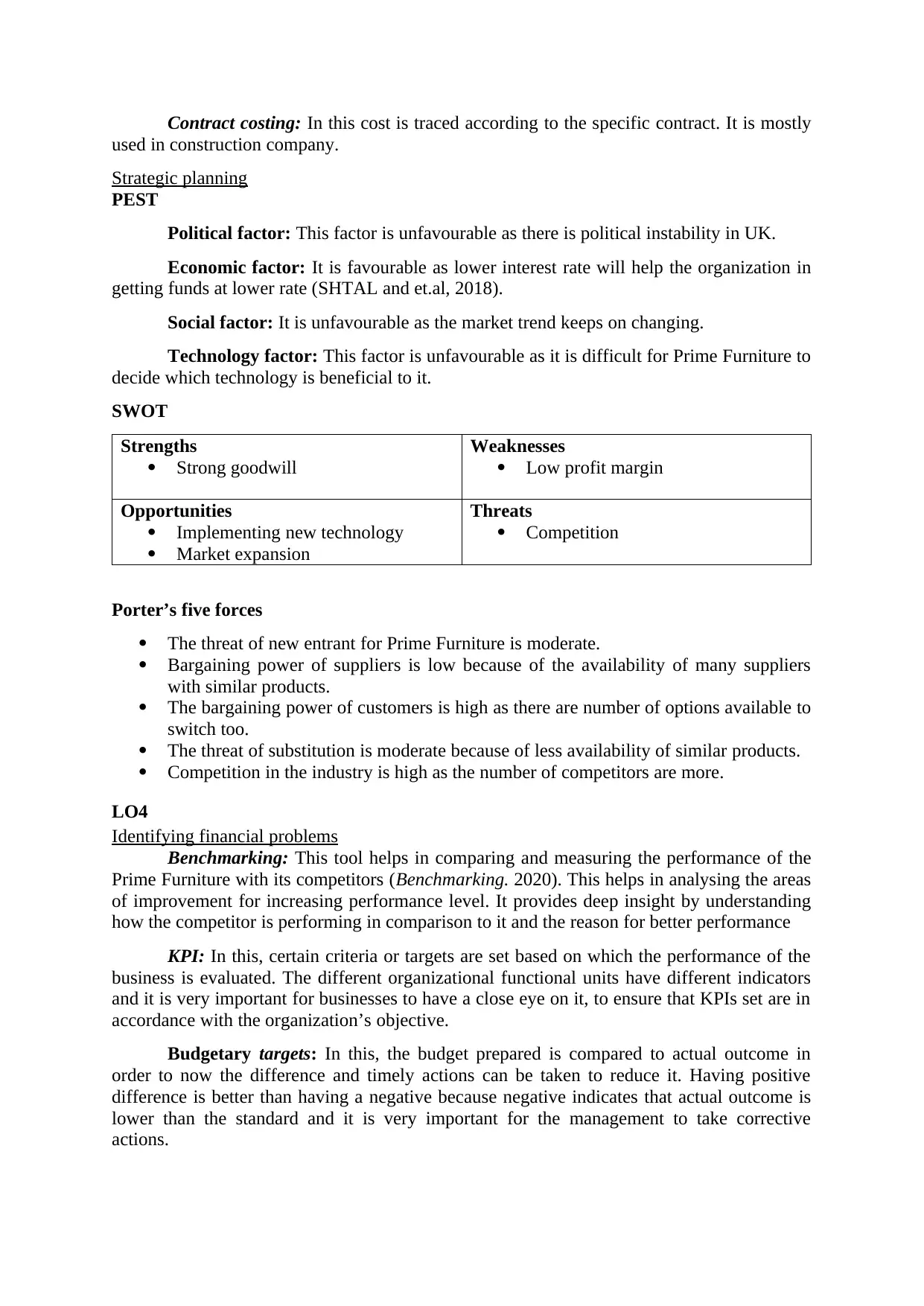
Contract costing: In this cost is traced according to the specific contract. It is mostly
used in construction company.
Strategic planning
PEST
Political factor: This factor is unfavourable as there is political instability in UK.
Economic factor: It is favourable as lower interest rate will help the organization in
getting funds at lower rate (SHTAL and et.al, 2018).
Social factor: It is unfavourable as the market trend keeps on changing.
Technology factor: This factor is unfavourable as it is difficult for Prime Furniture to
decide which technology is beneficial to it.
SWOT
Strengths
Strong goodwill
Weaknesses
Low profit margin
Opportunities
Implementing new technology
Market expansion
Threats
Competition
Porter’s five forces
The threat of new entrant for Prime Furniture is moderate.
Bargaining power of suppliers is low because of the availability of many suppliers
with similar products.
The bargaining power of customers is high as there are number of options available to
switch too.
The threat of substitution is moderate because of less availability of similar products.
Competition in the industry is high as the number of competitors are more.
LO4
Identifying financial problems
Benchmarking: This tool helps in comparing and measuring the performance of the
Prime Furniture with its competitors (Benchmarking. 2020). This helps in analysing the areas
of improvement for increasing performance level. It provides deep insight by understanding
how the competitor is performing in comparison to it and the reason for better performance
KPI: In this, certain criteria or targets are set based on which the performance of the
business is evaluated. The different organizational functional units have different indicators
and it is very important for businesses to have a close eye on it, to ensure that KPIs set are in
accordance with the organization’s objective.
Budgetary targets: In this, the budget prepared is compared to actual outcome in
order to now the difference and timely actions can be taken to reduce it. Having positive
difference is better than having a negative because negative indicates that actual outcome is
lower than the standard and it is very important for the management to take corrective
actions.
used in construction company.
Strategic planning
PEST
Political factor: This factor is unfavourable as there is political instability in UK.
Economic factor: It is favourable as lower interest rate will help the organization in
getting funds at lower rate (SHTAL and et.al, 2018).
Social factor: It is unfavourable as the market trend keeps on changing.
Technology factor: This factor is unfavourable as it is difficult for Prime Furniture to
decide which technology is beneficial to it.
SWOT
Strengths
Strong goodwill
Weaknesses
Low profit margin
Opportunities
Implementing new technology
Market expansion
Threats
Competition
Porter’s five forces
The threat of new entrant for Prime Furniture is moderate.
Bargaining power of suppliers is low because of the availability of many suppliers
with similar products.
The bargaining power of customers is high as there are number of options available to
switch too.
The threat of substitution is moderate because of less availability of similar products.
Competition in the industry is high as the number of competitors are more.
LO4
Identifying financial problems
Benchmarking: This tool helps in comparing and measuring the performance of the
Prime Furniture with its competitors (Benchmarking. 2020). This helps in analysing the areas
of improvement for increasing performance level. It provides deep insight by understanding
how the competitor is performing in comparison to it and the reason for better performance
KPI: In this, certain criteria or targets are set based on which the performance of the
business is evaluated. The different organizational functional units have different indicators
and it is very important for businesses to have a close eye on it, to ensure that KPIs set are in
accordance with the organization’s objective.
Budgetary targets: In this, the budget prepared is compared to actual outcome in
order to now the difference and timely actions can be taken to reduce it. Having positive
difference is better than having a negative because negative indicates that actual outcome is
lower than the standard and it is very important for the management to take corrective
actions.
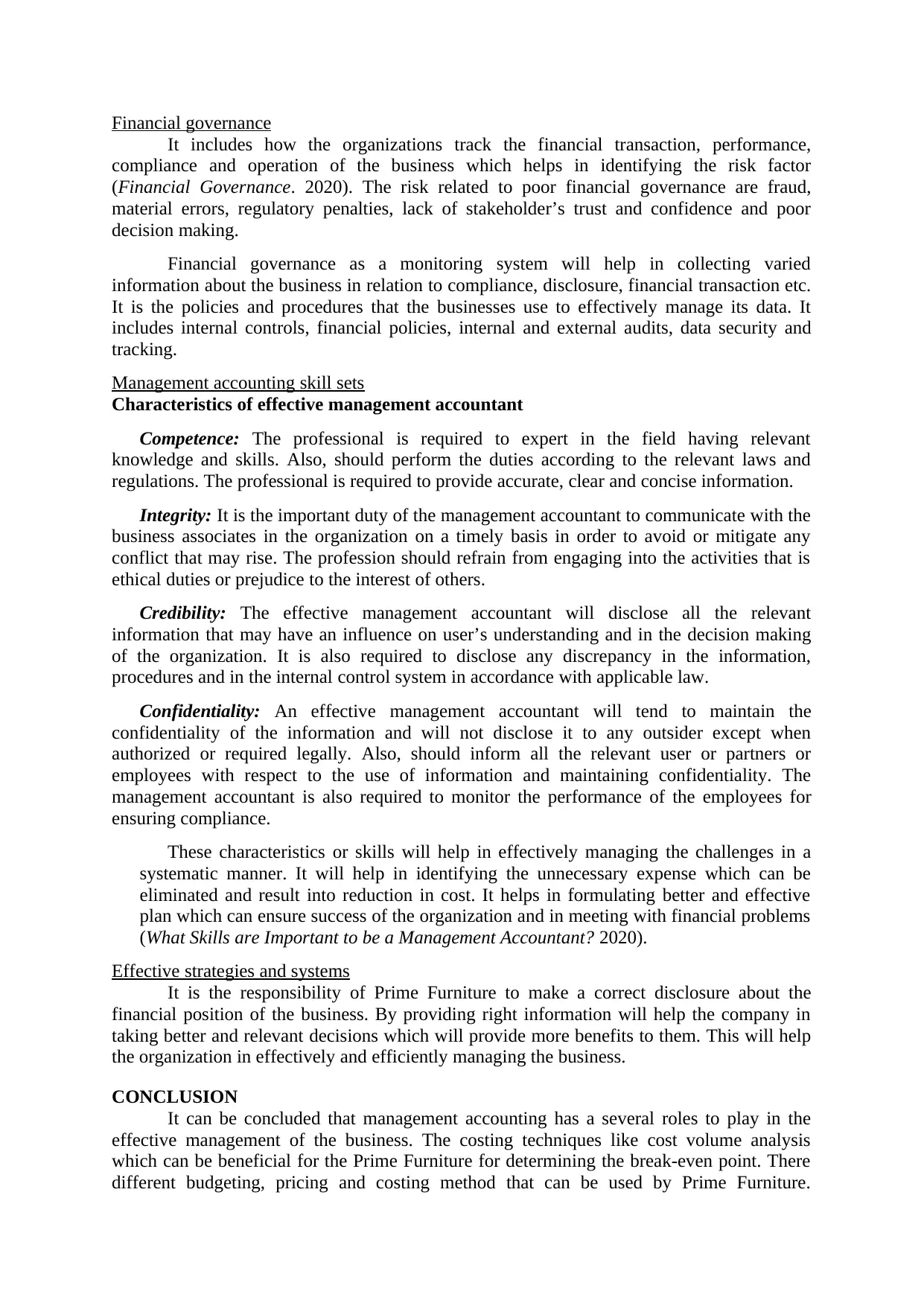
Financial governance
It includes how the organizations track the financial transaction, performance,
compliance and operation of the business which helps in identifying the risk factor
(Financial Governance. 2020). The risk related to poor financial governance are fraud,
material errors, regulatory penalties, lack of stakeholder’s trust and confidence and poor
decision making.
Financial governance as a monitoring system will help in collecting varied
information about the business in relation to compliance, disclosure, financial transaction etc.
It is the policies and procedures that the businesses use to effectively manage its data. It
includes internal controls, financial policies, internal and external audits, data security and
tracking.
Management accounting skill sets
Characteristics of effective management accountant
Competence: The professional is required to expert in the field having relevant
knowledge and skills. Also, should perform the duties according to the relevant laws and
regulations. The professional is required to provide accurate, clear and concise information.
Integrity: It is the important duty of the management accountant to communicate with the
business associates in the organization on a timely basis in order to avoid or mitigate any
conflict that may rise. The profession should refrain from engaging into the activities that is
ethical duties or prejudice to the interest of others.
Credibility: The effective management accountant will disclose all the relevant
information that may have an influence on user’s understanding and in the decision making
of the organization. It is also required to disclose any discrepancy in the information,
procedures and in the internal control system in accordance with applicable law.
Confidentiality: An effective management accountant will tend to maintain the
confidentiality of the information and will not disclose it to any outsider except when
authorized or required legally. Also, should inform all the relevant user or partners or
employees with respect to the use of information and maintaining confidentiality. The
management accountant is also required to monitor the performance of the employees for
ensuring compliance.
These characteristics or skills will help in effectively managing the challenges in a
systematic manner. It will help in identifying the unnecessary expense which can be
eliminated and result into reduction in cost. It helps in formulating better and effective
plan which can ensure success of the organization and in meeting with financial problems
(What Skills are Important to be a Management Accountant? 2020).
Effective strategies and systems
It is the responsibility of Prime Furniture to make a correct disclosure about the
financial position of the business. By providing right information will help the company in
taking better and relevant decisions which will provide more benefits to them. This will help
the organization in effectively and efficiently managing the business.
CONCLUSION
It can be concluded that management accounting has a several roles to play in the
effective management of the business. The costing techniques like cost volume analysis
which can be beneficial for the Prime Furniture for determining the break-even point. There
different budgeting, pricing and costing method that can be used by Prime Furniture.
It includes how the organizations track the financial transaction, performance,
compliance and operation of the business which helps in identifying the risk factor
(Financial Governance. 2020). The risk related to poor financial governance are fraud,
material errors, regulatory penalties, lack of stakeholder’s trust and confidence and poor
decision making.
Financial governance as a monitoring system will help in collecting varied
information about the business in relation to compliance, disclosure, financial transaction etc.
It is the policies and procedures that the businesses use to effectively manage its data. It
includes internal controls, financial policies, internal and external audits, data security and
tracking.
Management accounting skill sets
Characteristics of effective management accountant
Competence: The professional is required to expert in the field having relevant
knowledge and skills. Also, should perform the duties according to the relevant laws and
regulations. The professional is required to provide accurate, clear and concise information.
Integrity: It is the important duty of the management accountant to communicate with the
business associates in the organization on a timely basis in order to avoid or mitigate any
conflict that may rise. The profession should refrain from engaging into the activities that is
ethical duties or prejudice to the interest of others.
Credibility: The effective management accountant will disclose all the relevant
information that may have an influence on user’s understanding and in the decision making
of the organization. It is also required to disclose any discrepancy in the information,
procedures and in the internal control system in accordance with applicable law.
Confidentiality: An effective management accountant will tend to maintain the
confidentiality of the information and will not disclose it to any outsider except when
authorized or required legally. Also, should inform all the relevant user or partners or
employees with respect to the use of information and maintaining confidentiality. The
management accountant is also required to monitor the performance of the employees for
ensuring compliance.
These characteristics or skills will help in effectively managing the challenges in a
systematic manner. It will help in identifying the unnecessary expense which can be
eliminated and result into reduction in cost. It helps in formulating better and effective
plan which can ensure success of the organization and in meeting with financial problems
(What Skills are Important to be a Management Accountant? 2020).
Effective strategies and systems
It is the responsibility of Prime Furniture to make a correct disclosure about the
financial position of the business. By providing right information will help the company in
taking better and relevant decisions which will provide more benefits to them. This will help
the organization in effectively and efficiently managing the business.
CONCLUSION
It can be concluded that management accounting has a several roles to play in the
effective management of the business. The costing techniques like cost volume analysis
which can be beneficial for the Prime Furniture for determining the break-even point. There
different budgeting, pricing and costing method that can be used by Prime Furniture.
⊘ This is a preview!⊘
Do you want full access?
Subscribe today to unlock all pages.

Trusted by 1+ million students worldwide
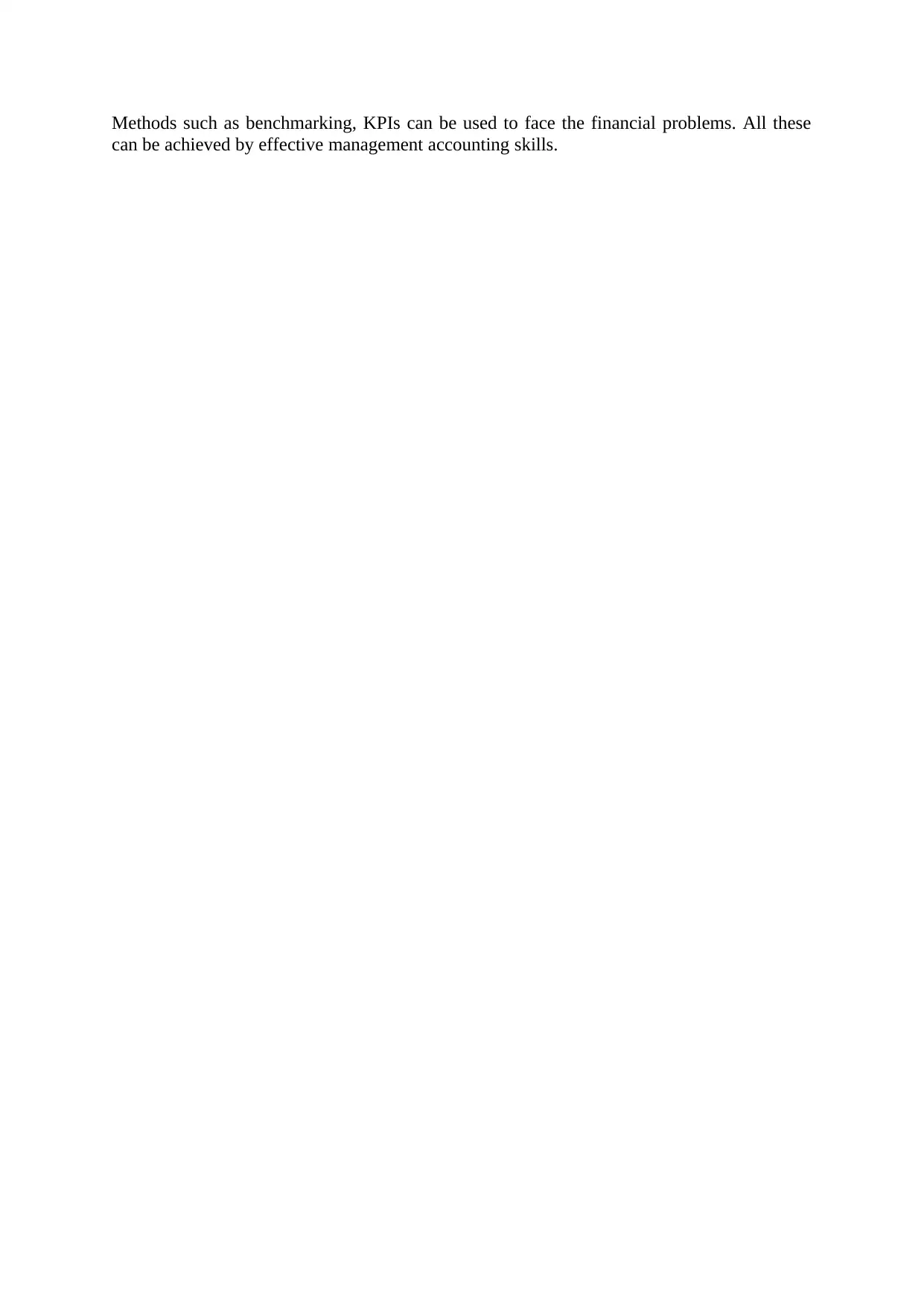
Methods such as benchmarking, KPIs can be used to face the financial problems. All these
can be achieved by effective management accounting skills.
can be achieved by effective management accounting skills.
Paraphrase This Document
Need a fresh take? Get an instant paraphrase of this document with our AI Paraphraser
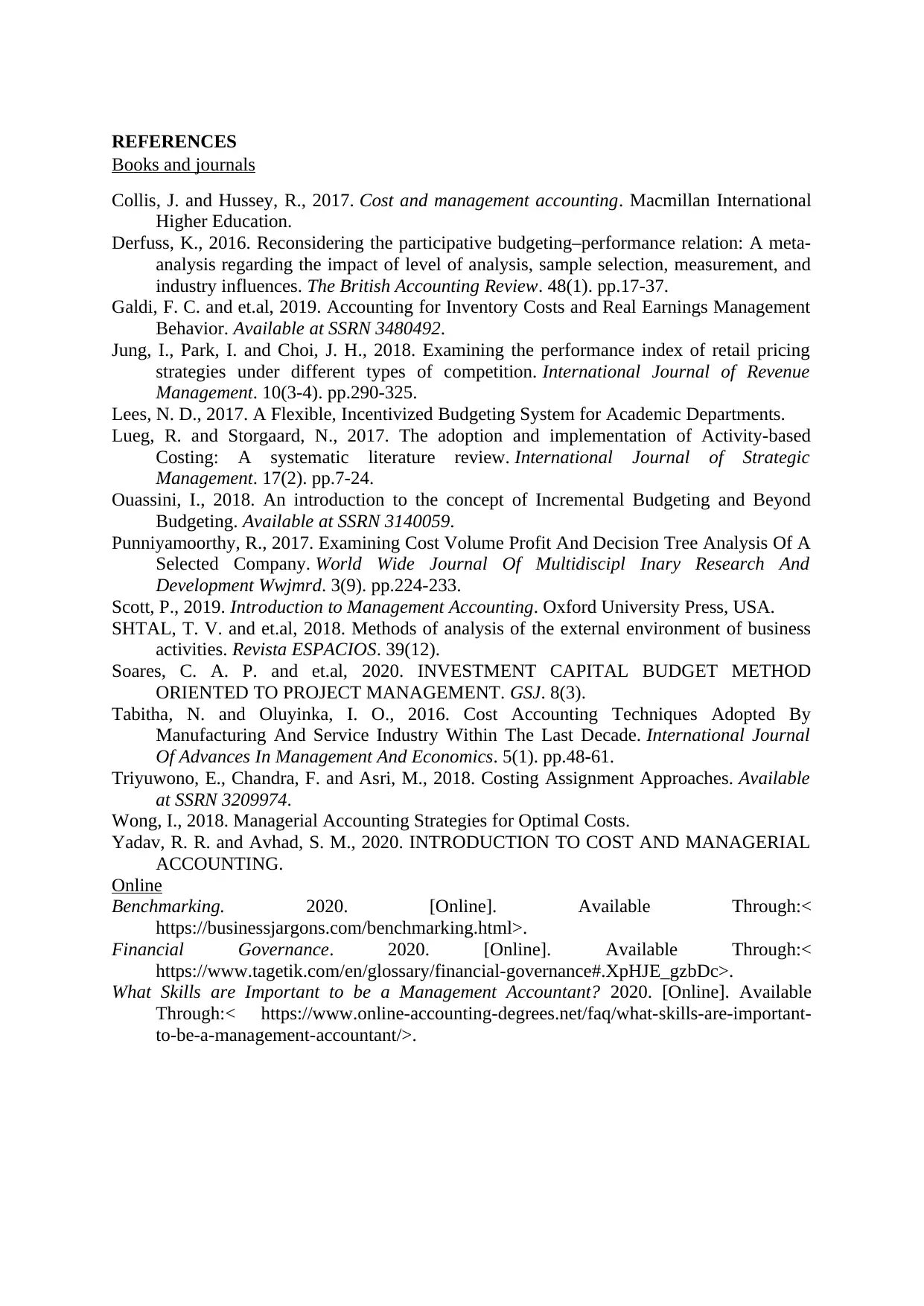
REFERENCES
Books and journals
Collis, J. and Hussey, R., 2017. Cost and management accounting. Macmillan International
Higher Education.
Derfuss, K., 2016. Reconsidering the participative budgeting–performance relation: A meta-
analysis regarding the impact of level of analysis, sample selection, measurement, and
industry influences. The British Accounting Review. 48(1). pp.17-37.
Galdi, F. C. and et.al, 2019. Accounting for Inventory Costs and Real Earnings Management
Behavior. Available at SSRN 3480492.
Jung, I., Park, I. and Choi, J. H., 2018. Examining the performance index of retail pricing
strategies under different types of competition. International Journal of Revenue
Management. 10(3-4). pp.290-325.
Lees, N. D., 2017. A Flexible, Incentivized Budgeting System for Academic Departments.
Lueg, R. and Storgaard, N., 2017. The adoption and implementation of Activity-based
Costing: A systematic literature review. International Journal of Strategic
Management. 17(2). pp.7-24.
Ouassini, I., 2018. An introduction to the concept of Incremental Budgeting and Beyond
Budgeting. Available at SSRN 3140059.
Punniyamoorthy, R., 2017. Examining Cost Volume Profit And Decision Tree Analysis Of A
Selected Company. World Wide Journal Of Multidiscipl Inary Research And
Development Wwjmrd. 3(9). pp.224-233.
Scott, P., 2019. Introduction to Management Accounting. Oxford University Press, USA.
SHTAL, T. V. and et.al, 2018. Methods of analysis of the external environment of business
activities. Revista ESPACIOS. 39(12).
Soares, C. A. P. and et.al, 2020. INVESTMENT CAPITAL BUDGET METHOD
ORIENTED TO PROJECT MANAGEMENT. GSJ. 8(3).
Tabitha, N. and Oluyinka, I. O., 2016. Cost Accounting Techniques Adopted By
Manufacturing And Service Industry Within The Last Decade. International Journal
Of Advances In Management And Economics. 5(1). pp.48-61.
Triyuwono, E., Chandra, F. and Asri, M., 2018. Costing Assignment Approaches. Available
at SSRN 3209974.
Wong, I., 2018. Managerial Accounting Strategies for Optimal Costs.
Yadav, R. R. and Avhad, S. M., 2020. INTRODUCTION TO COST AND MANAGERIAL
ACCOUNTING.
Online
Benchmarking. 2020. [Online]. Available Through:<
https://businessjargons.com/benchmarking.html>.
Financial Governance. 2020. [Online]. Available Through:<
https://www.tagetik.com/en/glossary/financial-governance#.XpHJE_gzbDc>.
What Skills are Important to be a Management Accountant? 2020. [Online]. Available
Through:< https://www.online-accounting-degrees.net/faq/what-skills-are-important-
to-be-a-management-accountant/>.
Books and journals
Collis, J. and Hussey, R., 2017. Cost and management accounting. Macmillan International
Higher Education.
Derfuss, K., 2016. Reconsidering the participative budgeting–performance relation: A meta-
analysis regarding the impact of level of analysis, sample selection, measurement, and
industry influences. The British Accounting Review. 48(1). pp.17-37.
Galdi, F. C. and et.al, 2019. Accounting for Inventory Costs and Real Earnings Management
Behavior. Available at SSRN 3480492.
Jung, I., Park, I. and Choi, J. H., 2018. Examining the performance index of retail pricing
strategies under different types of competition. International Journal of Revenue
Management. 10(3-4). pp.290-325.
Lees, N. D., 2017. A Flexible, Incentivized Budgeting System for Academic Departments.
Lueg, R. and Storgaard, N., 2017. The adoption and implementation of Activity-based
Costing: A systematic literature review. International Journal of Strategic
Management. 17(2). pp.7-24.
Ouassini, I., 2018. An introduction to the concept of Incremental Budgeting and Beyond
Budgeting. Available at SSRN 3140059.
Punniyamoorthy, R., 2017. Examining Cost Volume Profit And Decision Tree Analysis Of A
Selected Company. World Wide Journal Of Multidiscipl Inary Research And
Development Wwjmrd. 3(9). pp.224-233.
Scott, P., 2019. Introduction to Management Accounting. Oxford University Press, USA.
SHTAL, T. V. and et.al, 2018. Methods of analysis of the external environment of business
activities. Revista ESPACIOS. 39(12).
Soares, C. A. P. and et.al, 2020. INVESTMENT CAPITAL BUDGET METHOD
ORIENTED TO PROJECT MANAGEMENT. GSJ. 8(3).
Tabitha, N. and Oluyinka, I. O., 2016. Cost Accounting Techniques Adopted By
Manufacturing And Service Industry Within The Last Decade. International Journal
Of Advances In Management And Economics. 5(1). pp.48-61.
Triyuwono, E., Chandra, F. and Asri, M., 2018. Costing Assignment Approaches. Available
at SSRN 3209974.
Wong, I., 2018. Managerial Accounting Strategies for Optimal Costs.
Yadav, R. R. and Avhad, S. M., 2020. INTRODUCTION TO COST AND MANAGERIAL
ACCOUNTING.
Online
Benchmarking. 2020. [Online]. Available Through:<
https://businessjargons.com/benchmarking.html>.
Financial Governance. 2020. [Online]. Available Through:<
https://www.tagetik.com/en/glossary/financial-governance#.XpHJE_gzbDc>.
What Skills are Important to be a Management Accountant? 2020. [Online]. Available
Through:< https://www.online-accounting-degrees.net/faq/what-skills-are-important-
to-be-a-management-accountant/>.
1 out of 11
Related Documents
Your All-in-One AI-Powered Toolkit for Academic Success.
+13062052269
info@desklib.com
Available 24*7 on WhatsApp / Email
![[object Object]](/_next/static/media/star-bottom.7253800d.svg)
Unlock your academic potential
Copyright © 2020–2025 A2Z Services. All Rights Reserved. Developed and managed by ZUCOL.





